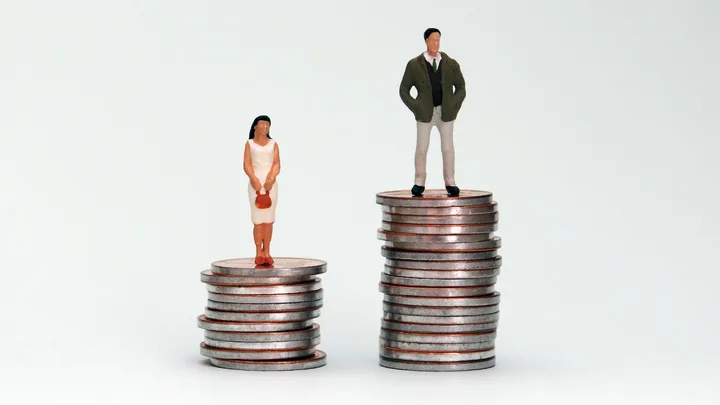The gender pay gap of every large Australian private company has been made public for the second time in history. This means Australians can find out the difference between how much the average male and female employee are paid at some of Australia’s biggest corporations, and see how their employers stack up.
This year, the findings reveal that while 56 per cent of employers improved their gender pay gap in the last twelve months, 79 per cent of employers still have a gender pay gap outside of the target range of 5 per cent.
Those numbers show that just one in five – or 21 per cent – of Australian companies have an average gender pay gap that sits within -5 per cent or +5 per cent of the target range.
Published by the government’s Workplace Gender Equality Agency, the findings take into account the average remuneration package – which includes super, bonuses, and any overtime paid during the period encompassing April 2023-March 2024.
It showed that, on average, women earn $28,425 less than their male cohort, which equates to roughly 78 cents on average for every $1 earned by men.
However, the results also show that progress is very much happening, albeit at a slower pace than many would hope.
The publication of the data comes as a result of the transparency amendments made to the Workplace Gender Equality Act 2012 in March 2023. Prior to the amendments, the gender pay gap data collected by the Workplace Gender Equality Agency (WGEA) was not publicly accessible. Now, the WGEA has expanded on its results once more, publishing data from 7,800 individual employers and 1,700 corporate groups – allowing employees working for a company that may be owned by a larger corporation or umbrella group – the same access as those working for smaller companies.
WGEA CEO Mary Wooldridge said that while the results are a promising step in the right direction, there’s still a long way to go until we see real and impactful change across Australian industries in general.
“Where an employer’s gender pay gap is beyond the target range of +/-5%, it indicates one gender is more likely to be over-represented in higher paying roles compared to the other. This can be a sign of structural or cultural differences for one gender within an occupation, organisation, or broader industry.
“For employers that haven’t made progress, it’s time to ask why – dig into the data to find out what’s causing any gender differences and use evidence-based solutions to address them.
“The new results, which use information reported by employers covering the time period immediately leading up to WGEA’s first release of gender pay gaps, suggests anticipation of publication generated positive flow on effects.”

Which Australian Companies Have The Biggest Gender Pay Gaps?
The latest finding revealed that almost every industry in Australia has a pay gap favouring men, but the highest gap exists in male-dominated industries such as construction and finance.
While those two industries account for a 25.3 per cent and 22.2 per cent gap respectively, they also reported a reduction of 6.5 per cent in the construction sector, and a 3.9 per cent dip in the finance sector – which is undoubtedly a step in the right direction.
However, while some industries are seeing positive results in their efforts to minimise and close the pay gap altogether, others reported a significant widening.
The mining industry was one of the biggest culprits, increasing its gender pay gap from 15.1 percent (2024) to 19.8 per cent, speaking to a general trend that shows the higher a company’s average remuneration package, the more its gender pay gap tends to favour men.
What Is The Difference Between Equal Pay and The Gender Pay Gap?
The gender pay gap shouldn’t be confused with equal pay, which refers to men and women being paid the same wage for doing the same job.
The gender pay gap however, which is calculated by the WGEA, measures the difference in average pay between men and women. To do this, the measure takes other contributing factors into consideration, including the differences between hours worked and all other forms of employment-related pay, including superannuation.
Currently, Australia’s gender pay gap sits at 13.3 percent. This gap is largely put down to women being more likely to work in low-paid industries and take more parental leave, which can harm their career progression. Men, on the other hand, are still holding more senior positions in Australian companies.
How Will Greater Transparency Change Things?
There are many reasons for making companies’ gender pay gaps public. It’s believed that one of the the biggest contributors to the gender pay gap is a lack of transparency and information.
Publishing the gender pay gap aims to equip employees with the information to make better negotiations with their employers, and inspire companies to make changes at their workplace.
“It’s promising to see the big increase in the number of employers working to understand what is driving their gender pay gap, beyond unequal pay,” agrees Wooldridge.
“Over the past year, employers have told us that publication of employer gender pay gaps is a catalyst to assess gender-based differences in all areas of their workplace.
“For men, a more equal experience could mean their employer is providing access to paid parental leave, paying superannuation on that leave and actively supporting a flexible return to work from parental leave,” she added.
“For women, it could mean their employer is redesigning manager roles that will enable those roles to be undertaken on a part-time basis or as a job share. This action can create new pathways to career progression for employees with caring or other responsibilities outside of work, or by actively broadening the pipeline of talent across occupations and job roles.”
How Do I Find The Gender Pay Gap Of My Company?
You can find the gender pay gap of your organisation on the Workplace Gender Equality Agency website.
Employers are also able to provide an optional Employer Statement that gives context to their gender gap gap results—a link to the statement will be displayed alongside each employer’s gender pay gap.
But while the public disclosures are a step in the right direction towards closing the gender pay gap, the latest report highlights the need for ongoing transparency in the fight towards closing the gap for good, a fight that calls for a collective shift in workplace culture overall, said Wooldridge.
“What is common to each is purposeful action that breaks down traditional notions of what it means to be a worker and carer in the contemporary workplace.”



